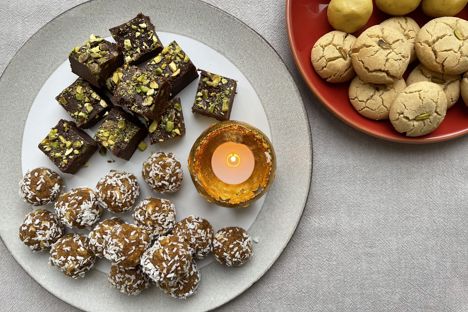
A feast for the senses: Maunika Gowardhan on Diwali
Maunika Gowardhan reminisces about her childhood Diwali celebrations, talks us through the vast range of traditional sweets and snacks served throughout the festival, and tells us how she celebrates here in the UK.
A feast for the senses: Maunika Gowardhan on Diwali
Maunika Gowardhan reminisces about her childhood Diwali celebrations, talks us through the vast range of traditional sweets and snacks served throughout the festival, and tells us how she celebrates here in the UK.
The most popular Hindu festival, Diwali, the festival of lights, falls on the 12th November this year. The five days of celebrations begin with Hindu rituals and fireworks amidst the festivities and, of course, delicious food shared with family and friends. The festival, which gets its name from the Sanskrit for “row of lanterns”, lands on a different date every year depending on the Hindu calendar and sees celebrants lighting diyas, to signify the triumph of light over darkness and good over evil among the Hindu, Sikh, and Jain communities.
There are so many traditions to mark the occasion regionally. In Varanasi on the bank of the river Ganga, prayers are recited by the river with an array of floating clay lanterns making it such a stunning sight. I was fortunate enough to visit Andhra on one of my travels to India and attend a Satyabhama puja (a Hindu worship ritual) which was vibrant, full of colour and tranquility, followed by the beginning of Diwali celebrations. Whilst in the east of India, the locals in Odisha pay their respects to their ancestors and burn jute sticks to bring in abundance and good fortune.
Celebrations, joy and sharing the festivities with family and friends are what unites us as a nation and community. Diwali is one of my favourite times of the year and takes me back to my home in Mumbai, India. The festivities are marked with a sense of euphoria and excitement, and our home was always filled with lots of sweets and savoury snacks throughout the weeks of celebrating. My mum always made sure we had new clothes made in time for the puja and our home was filled with family and friends every evening.
My family always had a puja to seek blessing, give thanks and to mark the event. My mother would teach me how to add rangoli at the entrance of the house, a powder in vibrant colours that marked the sign of letting all the positivity, good fortune and happiness make its way into our home.
As Maharashtrians, our households had faraal or huge tins of snacks (savoury and sweet) that were always stocked up for when we had guests coming over. Maybe this was just our excuse though! My favourites at home always include karanji (fried crispy pastry stuffed with a sweet coconut filling infused with grounds spices), chakli (often eaten with chai at my home; a savoury snack made with gram flour, lentils and spices fried until crisp and golden brown), anarsa (one of my favorites when I was younger, a sweet rice based biscuit cooked in ghee, jaggery and white poppy seeds), laddoos, and shankarpali (sweet crispy snacks cooked with ground cardamom, ghee and flour).
So many sweets are served during Diwali and the shops are brimming with a variety of mithai (Indian confectionary). Some of my favorites are sheera, a roasted nutty semolina dessert cooked in ghee, raisins and cashew nuts and served warm. Also, barfi (a type of Indian fudge) which is made in many flavours including pistachio, mango and chocolate, all infused with ground cardamom, crushed nuts and sometimes the addition of saffron. Gulab Jamuns served warm are another must have; these cardamom infused syrup-soaked dumplings topped crushed pistachio and almonds are perfect to make at home.
Aside from making and eating sweets, there are so many ways to revel in the excitement of the festival that I associate with from my childhood, and now bring into my own family home in the UK. Preparations in the weeks before to ready our home for Diwali mean that there are candles & diyas lit and sweets served for everyone visiting. I also love making little food hampers for close friends, and this year have made grated raw mango chutney in little jars, and I will also be putting together masala chai pouches to enjoy with that warm cup of tea. I’m including one of my favourite Indian sweets – Besan Laddoos. For these gram flour & ghee roasted laddoos, the gram flour is roasted until nutty and has a wonderful aroma. Adding a little bit of semolina to the mix gives a slightly grainy texture to the laddoos with a hint of ground cardamom and raisins for sweetness. They are delicious, easy to make and keep for weeks in an airtight container. I will, of course always save a few for myself to tuck in with a warm mug of chai!
Cooking an Indian feast with a delicious variety of curries, Indian flatbreads, raita, salad, side veg dishes and a lovely Indian dessert to end the meal is what the festivities are all about too. During the week-long celebration, I never miss the opportunity to make Batatchi Bhaji (spiced garlicky chilli crushed potatoes) to serve with crispy fried puris and some Shrikhand as well. Shrikhand is a traditional sweet from the west of India made with strained yoghurt, saffron, cardamom and pistachio. The best way to eat it is with the fried puris – indulgent, and so good. When cooking for family and friends, I always have a variety of pickles, chutneys and papad on the dinner table, too. These add taste & textures to make the Indian meal more elaborate. Snacks include aloo tikkis, tandoori skewers followed by biryani and curries.
Here’s wishing you a very Happy Diwali with hope, joy, prosperity and happiness (and loads of sweets) coming your way!

